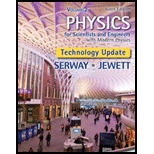
Concept explainers
A laboratory
(a)
Answer to Problem 29.10P
Explanation of Solution
Given info: A magnetic field of magnitude
Explanation:
The formula to calculate the Magnetic force acting on a moving charge particle is,
Here,
The cross product of
Here,
Substitute
The cross product is maximum for
The mass of proton is
Substitute
Conclusion:
Therefore, the maximum magnetic force that is exerted on the proton is
(b)
Answer to Problem 29.10P
Explanation of Solution
Given info: A magnetic field of magnitude
Explanation:
The formula to calculate the force acting on a proton of mass
Here,
Substitute
Conclusion:
Therefore, the magnitude of maximum acceleration of the proton is
(c)
Answer to Problem 29.10P
Explanation of Solution
Given info: A magnetic field of magnitude
Explanation:
The formula to calculate the Magnetic force acting on a moving charge particle is,
Here,
The cross product of
Here,
Substitute
The cross product is maximum for
The mass of electron is
Substitute
Conclusion:
Therefore, the maximum magnetic force that is exerted in the case of proton is same for the electron.
(d)
Answer to Problem 29.10P
Explanation of Solution
Given info: The proton makes an angle of
Explanation:
The formula to calculate the force acting on a proton of mass
Here,
Substitute
Conclusion:
Therefore, the magnitude of maximum acceleration obtained in the case of proton is not same for the electron.
Want to see more full solutions like this?
Chapter 29 Solutions
Physics For Scientists And Engineers, Volume 2, Technology Update
- A proton travels with a speed of 3.00 106 m/s at an angle of 37.0 with the direction of a magnetic field of 0.300 T in the +y direction. What are (a) the magnitude of the magnetic force on the proton and (b) its acceleration?arrow_forwardWhat magnetic field is required in order to confine a proton moving with a speed of 4.0 × 106 m/s to a circular orbit of radius 10 cm?arrow_forwardRank the magnitudes of' the forces exerted on the following particles from largest to smallest. In your ranking, display any cases of equality, (a) an electron moving at 1 Mm/s perpendicular to a 1-mT magnetic field (b) an electron moving at 1 Mm/s parallel to a 1-mT magnetic field (c) an electron moving at 2 Mm/s perpendicular to a 1-mT magnetic field (d) a proton moving at 1 Mm/s perpendicular to a 1-mT magnetic field (e) a proton moving at 1 Mm/s at a 45 angle to a 1-mT magnetic fieldarrow_forward
- A charged particle is traveling through a uniform magnetic field. Which of the following statements are true of the magnetic field? There may be more than one correct statement. (a) It exerts a force on the particle parallel to the field. (b) It exerts a force on the particle along the direction of its motion. (c) It increases the kinetic energy of the particle. (d) It exerts a force that is perpendicular to the direction of motion. (e) It does not change the magnitude of the momentum of the particle.arrow_forwardA wire 2.80 m in length carries a current of 5.00 A in a region where a uniform magnetic field has a magnitude of 0.390 T. Calculate the magnitude of the magnetic force on the wire assuming the angle between the magnetic field and the current is (a) 60.0, (b) 90.0, and (c) 120.arrow_forwardA 1.00-kg ball having net charge Q = 5.00 C is thrown out of a window horizontally at a speed v = 20.0 m/s. The window is at a height h = 20.0 m above the ground. A uniform horizontal magnetic field of magnitude B = 0.010 0 T is perpendicular to the plane of the balls trajectory. Find the magnitude of the magnetic force acting on the ball just before it hits the ground. Hint: Ignore magnetic forces in finding the balls final velocity.arrow_forward
- A cosmic-ray proton in interstellar space has an energy of 10.0 MeV and executes a circular orbit having a radius equal to that of Mercury’s orbit around the Sun (5.80 × 1010 m). What is the magnetic field in that region of space?arrow_forwardIf a charged particle moves in a straight line, can you conclude that there is no magnetic field present?arrow_forwardCalculate the magnitude of the magnetic field at a point 25.0 cm from a long, thin conductor carrying a current of 2.00 A.arrow_forward
 Physics for Scientists and EngineersPhysicsISBN:9781337553278Author:Raymond A. Serway, John W. JewettPublisher:Cengage Learning
Physics for Scientists and EngineersPhysicsISBN:9781337553278Author:Raymond A. Serway, John W. JewettPublisher:Cengage Learning
 Principles of Physics: A Calculus-Based TextPhysicsISBN:9781133104261Author:Raymond A. Serway, John W. JewettPublisher:Cengage Learning
Principles of Physics: A Calculus-Based TextPhysicsISBN:9781133104261Author:Raymond A. Serway, John W. JewettPublisher:Cengage Learning Physics for Scientists and Engineers: Foundations...PhysicsISBN:9781133939146Author:Katz, Debora M.Publisher:Cengage Learning
Physics for Scientists and Engineers: Foundations...PhysicsISBN:9781133939146Author:Katz, Debora M.Publisher:Cengage Learning College PhysicsPhysicsISBN:9781285737027Author:Raymond A. Serway, Chris VuillePublisher:Cengage Learning
College PhysicsPhysicsISBN:9781285737027Author:Raymond A. Serway, Chris VuillePublisher:Cengage Learning College PhysicsPhysicsISBN:9781305952300Author:Raymond A. Serway, Chris VuillePublisher:Cengage Learning
College PhysicsPhysicsISBN:9781305952300Author:Raymond A. Serway, Chris VuillePublisher:Cengage Learning





